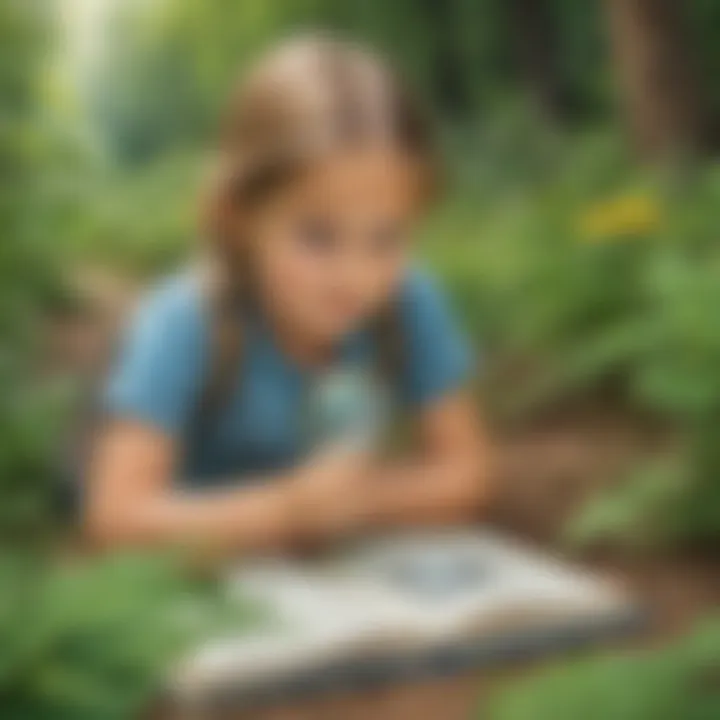Engaging Summer Activities for First Graders


Intro
Summer offers a unique opportunity for first graders to explore new ideas and develop skills outside the confines of a classroom. Engaging kids in activities that blend learning and fun enhances their overall growth. This guide outlines a variety of summer activities aimed at fostering curiosity, creativity, and physical development among young children. Parents, caregivers, and educators can utilize these activities to create enriching experiences that promote a love for learning without the pressure of formal education.
Science Fun Facts
Science is full of surprises and wonders that can spark a child's interest. Sharing fun facts with first graders can ignite their scientific curiosity and motivate them to explore more.
Interesting Trivia and Facts
- Did you know that honey never spoils? Archaeologists found pots of honey in ancient Egyptian tombs that are over 3,000 years old and still edible.
- A single teaspoon of honey represents the life's work of 12 bees.
Quirky Science Stories
Stories like the discovery of penicillin by Alexander Fleming highlight the importance of observation in science. After accidentally leaving a petri dish uncovered, Fleming noticed that mold killed bacteria. Such moments illustrate how mistakes can lead to groundbreaking discoveries.
Amazing Science Records
In the realm of science, records can be fascinating. For instance, the largest snowflake ever recorded measured 15 inches wide! This curiosity can lead to discussions about weather, climate, and nature.
Thought-Provoking Questions
Engaging first graders with questions can stimulate their thinking. Questions like, "What do you think happens to leaves in winter?" can lead to explorations about seasons and plant biology.
Discover the Wonders of Science
Dive into various scientific concepts suitable for young learners. By focusing on interactive and engaging resources, parents can enhance their child's summer experience.
Exploring Various Scientific Concepts
Activities such as observing insects in the backyard or exploring the life cycle of butterflies can make science tangible. Each experience shapes their understanding.
Educational Videos and Animations
Utilizing platforms like YouTube can offer educational videos designed for kids. This visual element can help them grasp complex ideas in a fun way.
Interactive Learning Tools
Websites featuring interactive games can cater to scientific learning. For instance, PBS Kids offers many educational games that focus on different scientific themes.
Real-Life Applications of Science
Encouraging kids to notice the world around them can foster a love of science. Discuss phenomena like the way rainbows occur after rain, making science part of their daily life experiences.
Science Quiz Time
Quizzes can be an effective and entertaining way to assess what children have learned. Engaging first graders with fun challenges can solidify their knowledge.
Interactive Quizzes
Websites such as Quizlet offer customizable quizzes. Parents and educators can create quizzes based on what kids have learned throughout the summer.
Multiple Choice Questions
Questions like "What gas do plants need to survive? A) Oxygen B) Carbon Dioxide C) Nitrogen" can help reinforce learning in a playful manner.
Brain Teasers and Puzzles
Finally, simple puzzles involving scientific themes can sharpen cognitive skills. Websites with kid puzzles make science enjoyable.
Science Experiment Showcase
Hands-on experiments can captivate a child's imagination and encourage exploration.
Fun and Engaging Experiments
Conducting simple experiments like growing beans in cotton can teach them about plant growth. It requires minimal materials and can be done at home.
Step-by-Step Instructions
Clear instructions are essential for successful experiments.
- Place cotton balls in a cup.
- Moisten the cotton balls slightly.
- Place a few bean seeds on top of the cotton.
- Keep them in sunlight and observe daily.
Materials List
Necessary materials for the bean experiment include:
- Cotton balls
- Bean seeds
- Plastic cup
- Water
Safety Tips and Precautions
Remind children to wash their hands after experimenting and to handle seeds carefully. Also, ensure that they are supervised during experiments to maintain safety.


"Science is just that simple—it’s a way of thinking about the world."
Through these engaging activities, parents and caregivers can create enriching experiences for first graders, making the summer a time for discovery and growth.
Prelude to Summer Learning
Summer offers a unique opportunity for first graders to engage in activities that blend fun with education. The transition from structured learning in the classroom to the less rigid environment of summer can sometimes spark concerns around learning retention. This article discusses how engaging summer activities can help maintain a child's educational momentum while promoting exploration and creativity.
Importance of Summer Activities
Combating summer learning loss
Summer learning loss occurs when students forget material learned during the school year. It can be troubling for young learners as this can lead to gaps in knowledge. Combating summer learning loss through engaging activities is essential for ensuring that first graders retain foundational concepts. This aspect of summer engagement aims to keep the mind active, bridging the gap until the new school year begins. By participating in educational fun, children not only remember what they have learned but also reinforce it through application.
The benefits of promoting retention through enjoyable activities are abundant. It transforms learning from a task to a playful adventure that children look forward to. Parents can incorporate small educational elements into daily routines, making a noticeable difference in a child’s readiness for the next grade.
"Learning should never stop, even during summer break. Making education enjoyable encourages children to embrace knowledge."
Encouraging exploration and curiosity
Exploration and curiosity are vital aspects of child development. Encouraging these traits during summer helps children discover their interests outside a formal classroom setting. When first graders have the chance to explore the world around them, it strengthens their cognitive skills, problem-solving abilities, and sense of independence. Engaging in exploratory activities, like nature walks or simple science experiments, cultivates a natural love for learning.
The key characteristic here is the freedom for children to ask questions and seek answers based on their experiences. This approach goes beyond traditional methods and fosters a deeper connection to the subject matter. Encouraging curiosity lets children lead their own learning, making them more invested and enthusiastic.
Overview of Suitable Activities
Outdoor experiences
Engaging in outdoor experiences contributes immensely to a child’s physical and emotional well-being. First graders can benefit from activities such as hiking, playing sports, or conducting science experiments outside. These experiences promote physical activity, which can help sharpen focus and overall health. Outdoor activities are also beneficial as their dynamic nature caters to varied interests.
Unique features of outdoor experiences include the opportunity to learn about ecosystems, weather, and natural phenomena firsthand. Such activities allow children to interact with their surroundings, promoting a better understanding of science in an engaging way.
Indoor projects
Indoor projects provide an alternative to outdoor fun, especially on hotter days or when weather conditions are not favorable. Arts and crafts, science experiments in the kitchen, or reading can all take place indoors, stimulating creativity and critical thinking.
Key characteristics include their versatility and accessibility. Indoor projects often require minimal supplies, making them easy to organize. This flexibility allows parents and caregivers to encourage learning without the need for extensive planning or travel. However, it is still essential to balance indoor activities with outdoor experiences for well-rounded development.
Outdoor Activities
Outdoor activities play a vital role in the development of first graders. They are not just a source of fun but also a means of stimulating physical health, social skills, and cognitive growth. Engaging in outdoor pursuits encourages children to interpret and understand their environment. Activities in nature promote learning through experience, which is more impactful than classroom learning.
Moreover, outdoor activities provide opportunities for children to work in groups or teams, fostering communication and socialization. It builds their confidence as they undertake challenges, explore the outdoors, and find joy in movement. Each of these elements contributes to a well-rounded summer experience.
Nature Walks and Exploration
Nature walks and exploration provide first graders a chance to discover the world around them. Engaging children in the identification of local flora and fauna taps into their innate curiosity. This not only broadens their knowledge about life sciences but also encourages observation skills. When children learn to identify local plants and animals, they develop a sense of place and appreciation for biodiversity. This groundedness is important for nurturing responsible future citizens.
In addition, exploring nature allows kids to observe ecosystems in action. Identifying local flora and fauna fosters a deep connection between kids and their environment, underpinning environmental awareness.
Identifying local flora and fauna
Identifying local flora and fauna encourages children to engage with their surroundings actively. The key characteristic is its adaptability. Children can often find various plants and animals right in their backyards or nearby parks. This immediacy makes it a popular choice for summer activities.
By focusing on local species, children can develop observational skills and foster a sense of belonging. The unique feature of this activity lies in its potential to inspire a lifelong interest in nature. An advantage is that this activity doesn't require specialized materials and fosters outdoor exploration. However, the disadvantage is that it may not captivate every child, depending on their interest levels.
Using nature journals
Using nature journals turns observation into a tangible record of learning. The act of documenting experiences enhances retention of information. A nature journal is an essential tool for young explorers. Children can sketch plants, take notes, and jot down their thoughts. This process encourages them to articulate what they see and learn.
The key characteristic of nature journals is that they merge creativity with scientific inquiry. This combination makes them a crucial aspect of outdoor learning. Students can reflect and grow through personal expression, documenting changes in nature over time. The unique feature of a nature journal is its versatility; it can serve as a personal collection of experiences. This activity encourages imaginative thinking, but some children might find it challenging to draw or write.
Scientific Experiments in the Backyard
Scientific experiments in the backyard offer hands-on experience that intrigues young learners. These activities empower children to explore scientific principles in a tangible way. Hands-on learning helps children grasp concepts more effectively. It allows them to see real-world implications of scientific learning.
Experimenting with the environment stimulates curiosity and critical thinking. As they make observations and draw conclusions, they engage in the same processes that scientists use. This is an enriching experience that transcends theoretical learning.
Solar energy projects
Solar energy projects introduce first graders to renewable energy. Such projects can involve simple solar ovens or solar-powered toys. The key characteristic of solar energy projects is that they are directly connected to real-world applications. This practicality makes them especially engaging for children.
These hands-on experiences allow first graders to see how energy works in the world around them. The unique feature of these projects is their scalability; they can be tailored for different skill levels. An advantage is that they encourage critical thinking and problem-solving; however, they may require adult supervision, which can be a limitation.
Simple weather observations
Making simple weather observations helps children learn about meteorology. This can include tracking temperature, wind speed, or rainfall. It is essential for children to understand weather patterns, fostering an appreciation for natural phenomena.
The key characteristic of these observations is their accessibility; children can collect data daily. This repeated practice makes weather observations a beneficial and enriching experience. The unique feature is that it combines scientific inquiry with daily life. Children can monitor changes and understand their immediate environment. An advantage is increased awareness and conversation about climate and environment, while the disadvantage includes variability in weather that might affect consistency in observations.
Water Science Activities
Water science activities are engaging ways to introduce fundamental scientific principles. They encourage children to explore concepts like buoyancy, displacement, and material properties through play. Water provides a dynamic medium for discovery, inviting hands-on experimentation.
These activities are not only educational but also provide a refreshing experience in warm weather. They engage multiple senses and help children learn collaboratively.


Floating and sinking experiments
Floating and sinking experiments provide insights into density and buoyancy. These experiments help children understand why certain objects float while others sink. Engaging in this tactile activity makes complex concepts accessible.
The key characteristic of these experiments is that they are simple and can be done with household items. This simplicity makes floating and sinking a popular choice for summer activities. The unique feature is that these exercises encourage prediction and observation skills. An advantage is the immediate visual feedback children get from their experiments. However, the potential disadvantage is that variations in experimental conditions might lead to inconsistent results.
Simple boat building challenges
Simple boat building challenges merge creativity with physics. Children can use various materials to create boats that float. These tasks teach about materials, design, and engineering principles.
The key characteristic is that they allow for creative expression while addressing scientific concepts. These challenges are beneficial as they inspire teamwork in a fun environment. The unique feature is their adaptability; children can build boats of different sizes and weights. This adaptability is a key advantage, but it requires available materials, which may limit some participants.
Garden Projects
Garden projects empower children to understand biology as they engage in hands-on learning. Starting a vegetable garden promotes responsibility and patience. First graders learn to nurture plants, observing growth over time, which connects them to the food they eat.
These activities offer practical insights into plant biology, helping children understand life cycles and ecology. Working with the earth cultivates a sense of stewardship towards nature.
Starting a vegetable garden
Starting a vegetable garden gives kids a sense of accomplishment as they see their efforts yield tasty results. This contributes to overall well-being through nutrition and physical activity. The key characteristic of starting a vegetable garden is its ability to teach children about self-sufficiency and responsibility.
It is a beneficial choice because it offers tangible and delicious rewards. The unique features include developing patience as they wait for crops to grow and gaining an understanding of the food system. The advantage is enhanced nutritional education, while the disadvantage may include challenges in care and maintenance.
Understanding plant biology
Understanding plant biology deepens awareness of ecosystems and gardening. Children can learn about photosynthesis, growth patterns, and the role of roots. This knowledge builds a foundation for advanced science learning.
The key characteristic of this understanding is that it is rooted in real-world experience. This direct connection to nature makes it a popular choice among educators and parents. The unique feature of studying plant biology is linking theoretical knowledge with practical application. An advantage is enhanced curiosity about the natural world, while the disadvantage is the complexity of some concepts that may require adult explanation.
Indoor Activities
Indoor activities play a critical role in a child's summer learning experience. With hot days or unexpected rain showers, indoor activities ensure children remain engaged and continue learning even when outdoor options are limited. They provide an opportunity to explore creativity, develop fine motor skills, and stimulate intellectual curiosity. These activities can be varied and tailored to suit the needs and interests of first graders, making them essential for forming a well-rounded summer.
Creative Arts and Crafts
Science-themed crafts
Science-themed crafts offer a unique way to blend creativity with learning. Children can create models of the solar system, make weather-related art, or even design experiments that demonstrate physical properties like buoyancy. This hands-on approach helps solidify scientific concepts in a fun way, making learning memorable. Children can use everyday materials from around the home, which emphasizes resourcefulness and environmental awareness.
The key characteristic of science-themed crafts is their capacity to integrate lessons with tactile learning. They are beneficial because children are likely to remember what they create, reinforcing their understanding of complex science topics through practical application. One disadvantage to consider is the level of adult supervision required, especially for projects using sharp objects or messy materials. Careful planning can mitigate these issues.
Nature-inspired art
Nature-inspired art connects children with the world around them, encouraging them to observe and appreciate natural materials. This form of art can involve using leaves, flowers, stones, or even soil to create unique masterpieces. Such activities enhance a child's observational skills while sparking discussions about ecology and the environment.
The distinctive feature of nature-inspired art is its reliance on natural elements, promoting sustainability and creativity. Children learn the importance of nature through artistic expression. This approach is popular because it seamlessly combines creativity with an ecological message. However, sourcing natural materials can be a challenge, as it requires time and effort to gather the right items, especially in urban settings.
Science Sensory Bins
Exploring textures and materials
Exploring textures and materials in science sensory bins offers a multi-sensory learning experience for first graders. These bins can be filled with various items like sand, water beads, and dried beans, allowing children to touch, feel, and manipulate different substances. This tactile engagement promotes sensory development and theories of physical science.
One of the core attributes of sensory bins is how they cater to multiple learning styles. They engage children who learn best through touch and movement while also fostering cognitive skills like problem-solving and critical thinking. However, constant supervision is often necessary to ensure safe play, particularly with small objects. Proper setup and clear instructions can help alleviate safety concerns.
Hands-on learning through play
Hands-on learning through play is central to a child's development. This method amplifies engagement by allowing children to explore concepts through action, making ideas come alive. Activities like building structures with blocks or creating simple machines foster creativity while teaching scientific principles like physics.
This approach is pivotal as it builds confidence, encourages teamwork, and cultivates innovation. The interactive nature of hands-on learning is appealing to young children, as it aligns closely with their natural instincts. However, one downside could be the potential for distractions, making it essential that activities are well-organized and focused.
Reading and Storytelling
Books about science and nature
Books about science and nature serve as a gateway for children to learn about the world. Titles that focus on natural phenomena, animal behaviors, or human impact on the environment can spark curiosity and discussion. Reading together also helps improve comprehension and vocabulary.
These books are beneficial because they can inspire a child’s interest in exploration and research. A unique feature is the availability of illustrated books that captivate young readers' attention. However, it is crucial to select age-appropriate materials to ensure comprehension; otherwise, children may lose interest.
Encouraging imaginative thinking
Encouraging imaginative thinking fosters creativity and problem-solving skills in children. Storytelling allows children to explore scenarios and characters, helping them develop critical thinking and emotional intelligence. As they create their own stories or role-play scenarios, they engage in a form of learning that is both intimate and impactful.
This practice is beneficial because it supports language development and nurtures social skills through collaborative storytelling. A unique aspect is the freedom given to children to explore their thoughts. Nevertheless, some children may feel less comfortable expressing their imagination, and ensuring that all children feel included may require additional effort from caregivers.
Physical Activities
Physical activities during the summer are pivotal for first graders. They help enhance physical health while offering opportunities for social interaction and collaboration. Engaging in these activities aids in the development of both gross and fine motor skills, which are essential at this developmental stage. Encouraging energetic play can also lead to reduced stress and promote overall well-being among children.
Outdoor Games
Traditional games and sports
Traditional games and sports are a key component of summer activities. They encourage teamwork and friendly competition among children. These games are often simple, requiring minimal equipment, making them easy to organize. Kids can enjoy activities like tag, hopscotch, or kickball. These types of play also foster social skills as children learn to cooperate and strategize with their peers.


A significant aspect of traditional games is that they often include physical challenges. Participating in these activities can lead to improved fitness levels. However, the downside may include potential injuries if safety precautions are not taken seriously.
Science-themed relay races
Science-themed relay races combine physical activity with educational elements. This innovative approach makes learning fun and interactive for first graders. Each station in the relay can focus on a scientific concept, allowing children to learn about topics like gravity, buoyancy, or simple machines as they participate.
A unique feature of these races is the engaging way they promote teamwork and cooperation. Children can share knowledge and work together to complete each task successfully. However, ensuring clarity in instructions is essential to avoid confusion among participants.
Dance and Movement
Exploring rhythm and body awareness
Exploring rhythm and body awareness through dance is an effective way to engage first graders. It allows them to express themselves while enhancing coordination and balance. Understanding rhythm also fosters a sense of timing, which is important in many physical activities and sports.
Dance encourages creativity, as children can invent movements that reflect their personality or mood. However, the challenge lies in ensuring every child feels included and free to express themselves without the fear of judgment.
Creating a science dance routine
Creating a science dance routine introduces a unique blend of physical activity and subject matter learning. By integrating scientific concepts into dance, children can internalize complex ideas in a fun and memorable way. This can involve movements that mimic animal behaviors or motions that illustrate scientific principles, such as the water cycle.
The advantage of this activity is that it can cater to various learning styles, making it accessible for all children. However, the complexity of choreography may vary, requiring adults to balance between guidance and allowing personal expression.
Physical activities are essential for healthy development in children, especially during the learning-intensive summer months.
Technology and Online Resources
In today’s digital age, integrating technology into summer activities can provide first graders with valuable learning experiences. Online resources and platforms can effectively enhance a child’s knowledge in a fun, engaging way. Notably, technology facilitates access to a vast array of educational materials that can complement traditional learning. These resources are particularly beneficial during the summer, helping to keep young minds active while still allowing for enjoyable play.
When discussing technology and online resources, it is essential to focus on two main components: educational apps and games, and virtual field trips. Each serves its own unique purpose in promoting interactive and enriching experiences.
Educational Apps and Games
Science exploration apps
Science exploration apps allow young learners to dive into basic scientific concepts through interactive activities. These apps often include features like quizzes, activities, and explanations tailored to first graders. The main advantage of these apps is their ability to transform complex scientific ideas into manageable and understandable chunks for children. By making learning interactive, they promote engagement and retention.
A standout quality of science exploration apps is their capacity for real-time feedback. This feature encourages children to learn from mistakes without feeling discouraged. Moreover, users can explore varied topics independently, which supports self-directed learning.
However, it is crucial to monitor screen time and the content accessed. Striking a balance is important so that apps complement rather than replace hands-on learning.
Interactive learning platforms
Interactive learning platforms offer a broad spectrum of educational activities. Such platforms keep children engaged while teaching them about different scientific and creative subjects. They typically include videos, quizzes, and interactive lessons that adapt to the learner's pace. This adaptability is particularly useful for maintaining engagement, as it allows children to revisit difficult topics or speed up through what they already know.
The unique feature of interactive learning platforms is their community aspect. Many allow children to interact with peers, encouraging collaboration and communication. This feature is vital for developing social skills, which are equally important as academic achievement.
Despite their benefits, accessibility may be an issue, as not all families may have reliable internet access. Hence, it is wise for parents to investigate platforms that offer offline options.
Virtual Field Trips
Exploring museums and science centers
Virtual field trips provide first graders with the chance to explore museums and science centers without the constraints of travel. These experiences can broaden children’s perspectives and expose them to various scientific phenomena and history. Virtual tours often feature interactive elements, engaging visuals, and informative narratives that capture a child's attention.
One key characteristic of these virtual trips is their ability to reach a wider audience. Families who may not afford to visit places in person can still access these educational resources.
That said, it is important to ensure that virtual content is age-appropriate. Parents should preview materials and activities to select those that align with their child’s learning needs.
Engaging video content
Engaging video content can serve as a powerful tool in capturing a child's interest. Videos can simplify complex concepts with visuals and stories, making them relatable. They often provide an immersive experience that can inspire curiosity about new topics.
The unique feature of engaging video content is its ability to present real-world applications and experiments. This encourages children to think critically about what they watch and often sparks questions. However, it’s crucial to curate viewing to include high-quality educational videos that promote active thinking rather than passive consumption.
"Technology offers an endless array of tools to enhance learning, but supervision is crucial. Ultimately, combining online resources with outdoor and hands-on activities leads to balanced education."
The End and Final Thoughts
Summary of Activities
Integrating learning with fun
Integrating learning with fun is a key aspect of the summer activities discussed in this article. This approach stands out because it connects educational concepts with enjoyable experiences. Such activities make learning less intimidating and more appealing to first graders. The unique feature here is that children learn naturally through play. This facilitates retention and understanding of knowledge.
One advantage of this integration is heightened motivation. When learning feels fun, children tend to engage more deeply. However, parents may need to ensure that the fun element does not overshadow the educational goals.
Encouraging a love for science
Encouraging a love for science is crucial for fostering curiosity in young minds. Activities that emphasize exploration and experimentation help build a foundation for scientific thinking. The key characteristic of this approach is that it welcomes questions and promotes inquiry.
This choice is beneficial as it inspires children to seek answers and solutions. Unique features include hands-on experiments that allow children to observe results firsthand. While this can make science accessible and exciting, it also requires careful planning to ensure safety and success.
Planning for a Successful Summer
Setting goals for learning
Setting goals for learning provides a framework for summer activities. This aspect is important as it helps prioritize educational outcomes. By defining clear objectives, parents can focus on what their children should achieve during the summer. One characteristic of goal-setting is its role in tracking progress.
It is a beneficial choice because it helps to identify areas of interest and potential improvement. A unique feature of this approach is adaptability; goals can evolve with the child's interests. However, it is important that these goals remain realistic to avoid unnecessary pressure.
Creating a balanced schedule
Creating a balanced schedule is critical to ensuring that activities are executed smoothly. This aspect contributes to overall success by allowing time for both learning and relaxation. One key characteristic is the incorporation of varied activities to prevent monotony.
This balance supports physical, emotional, and intellectual well-being. The unique feature of this schedule is flexibility; it accommodates unplanned events or interests. However, too much structure can limit spontaneity, so adjustments should be made as necessary.
A well-planned summer provides opportunities for growth and learning while allowing children to enjoy their break.
Overall, by focusing on these elements, parents can create a summer that is both engaging and educational, enhancing a child's love for learning.







